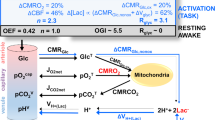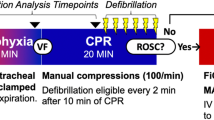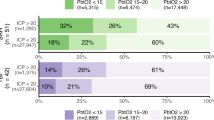Abstract
ABSTRACT: The relationship between a noninvasive determination of relative oxygen saturation of Hb circulating in brain tissue (StO2) and energy metabolism was investigated with respect to age dogs in three age groups (0 to 6- d-old, 7- to 21-d-old, and adults) and to severity of brain hypoxia using double beam spectroscopy of Hb deoxygenation and nuclear magnetic resonance spectroscopy of energy metabolism. The in vivo oxy-Hb dissociation was determined from the relationship between StO2 curve in the adult dog brain and sagittal sinus oxygen partial pressure during graded hypoxemia and found to be sigmoidal with an oxygen dissociation constant of 26.6 mm Hg. This agreed with an in vitro determination for oxygen dissociation constant of 28.2 mm Hg in adult dog red cells. The arterial oxygen pressure at which brain StO2 was reduced by 50% was shifted toward the right with increasing age (22.2,33.8, and 40.8 mm Hg, respectively). This correlated with an in vitro oxygen dissociation constant of red cell Hb of 17.0, 22.3, and 28.2 mm Hg in the three age groups, respectively. The phosphocreatine-inorganic phosphate ratio (PCr/Pi) was used to relate changes in cellular energy metabolism during hypoxia with changes in StO2. There was no change in PCr/Pi when StO2 had decreased to 50% of the control value. However, when the brain StO2 had decreased to between 7 and 15%, a reduction of PCr/Pi to 50% of the normoxic value occurred. The StO2 at which PCr/Pi falls should be considered a critical level of hypoxemia inasmuch as it represents a threshold of energy failure. There was no significant age dependence in the relationship between StO2 and PCr/Pi. Neonates had much smaller intravascular oxygen gradients than those in adults at a critical level of hypoxemia. However, compared with adults, the 1- to 3-wk-old age group requires a similar O2 availability and extraction for brain metabolic survival.
Similar content being viewed by others
Log in or create a free account to read this content
Gain free access to this article, as well as selected content from this journal and more on nature.com
or
Author information
Authors and Affiliations
Rights and permissions
About this article
Cite this article
Nioka, S., Chance, B., Smith, D. et al. Cerebral Energy Metabolism and Oxygen State during Hypoxia in Neonate and Adult Dogs. Pediatr Res 28, 54–55 (1990). https://doi.org/10.1203/00006450-199007000-00013
Received:
Accepted:
Issue date:
DOI: https://doi.org/10.1203/00006450-199007000-00013
This article is cited by
-
Shedding light on mitochondrial function by real time monitoring of NADH fluorescence: I. Basic methodology and animal studies
Journal of Clinical Monitoring and Computing (2013)
-
Near-infrared monitoring of the cerebral circulation
Journal of Clinical Monitoring (1993)



